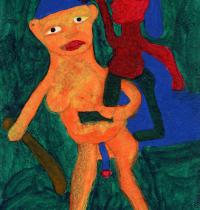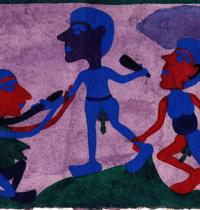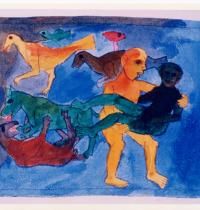Navjot Altaf
Grant Period: Over one year
Visual artist Navjot Altaf's fresh proposal underlined the creativity and tension that characterised the first phase of her collaboration with traditional artists Shantibai, Kumar, Kabi Ram and Ghassu Ram, and sought to continue the fruitful artistic processes initiated earlier. At the time of writing, the resulting individual and collective art works have already been exhibited to acclaim in Mumbai and are due to travel to Delhi and Japan early this year. The first phase, Navjot explains, came to an end in the studio space where the collaborators undertook a parallel exploration of two distinct arts practices. On one hand, traditional craftspersons were given the opportunity to redefine their living traditions in an environment normally associated with contemporary urban arts practice. On the other, Navjot, an urban artist, actively sought creative challenges in a context beyond the narrowly individualistic.
By the end of the project, the documentation also included Navjot's meticulously detailed diaries and a cache of video and audio material. Recordings of myths sung by Gurumais (women with ritual powers) in the region or the death songs of the Muria Tribe, as much as their visits and travel, inevitably fed into the team's creativity and spurred self-reflection. In the pipeline are a series of short films that will attempt to reflect the collaboration, which are also expected to accompany the present exhibited works. While Navjot has been articulate in stating her own goals as a dissatisfied urban visual artist, pointing to approaches that lie ahead, she is equally perceptive in helping to shape goals for her collaborators. Living on the common campus of Shilpi Kendra and working in a common studio space made the dialogue between collaborators possible while facilitating understanding of one another's methods of working. But this is a process far from complete.
Navjot admits that her collaborators have gradually begun to acknowledge that it is possible for them to give their opinions, and more importantly, to be taken seriously by her. While Navjot's work in the district may have assisted her to redefine her individuality within a specific group dynamic, travelling outside Bastar has enabled her collaborators to enlarge their pictorial vocabulary and to be introspective in a confident way. In the fresh grant, Dr. Shivaji Pannikar, a Baroda-based art historian, will show the group slides and assist learning and discussion while travelling with them to selected arts sites. In the final analysis, it is not artistic talent alone that will drive the project further, but the degree to which each collaborator is in a position to realise his or her creative power and potential. The last year, according to Navjot, has been helpful in dealing with issues of self-esteem.
The making of a film/films, conceived by Navjot as an interactive activity, mutually respectful of each participant's capabilities and capacities — forms an added and important dimension in the fresh proposal with two expected benefits. As before, the group will interact with the surrounding community. Shilpi Kendra, the cultural institution that originally agreed to play host to the project, is beset with an insecure leadership. While Navjot has steered the project responsibly, admirably avoiding conflict and continuing to be forthcoming and helpful, she is seized by the need to look for a better mooring and is in discussion with others in the district on this matter. She is quite clear that proceeds from the collaborative work will be equitably distributed, and will provide important clues on how the group can fund themselves in the long term.



